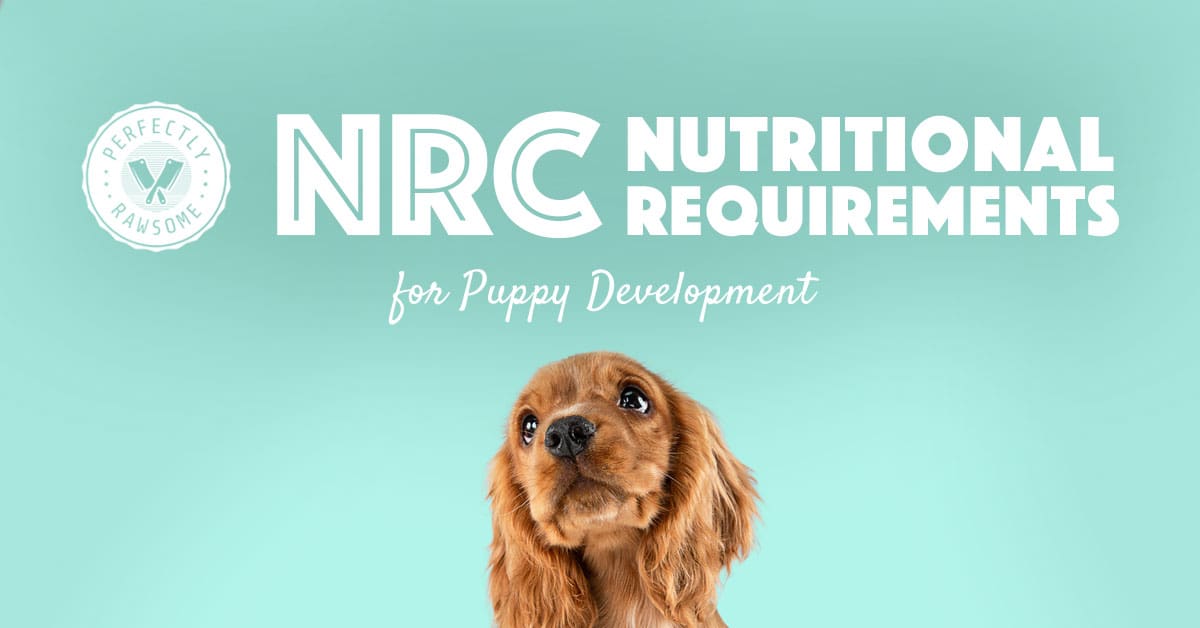Puppies cannot regulate vitamins and nutrients like an adult dog can, and puppies require a daily balanced diet. Biologically Appropriate Raw Food (BARF) model or Prey Model Raw (PMR) raw diets provide guidelines on items to include in a raw diet to provide essential nutrients and recommended calories for proper growth and development.
The ingredients included in a puppy’s raw diet need to be selected to ensure recommended allowances for essential nutrients are met daily.

Macronutrients for Puppies
Macronutrients are the first piece in nutrition where they are necessary for optimal health. There are three primary macronutrients which includes protein, lipids (fats), and carbohydrates. Each macronutrient is found in nearly all foods and supply calories for energy.
Recommended Daily Allowances for Macronutrients
Macronutrients are defined as a class of chemical compounds which are consumed in large quantities and provide the bulk of energy within the diet.
Proteins are large complex molecules composed of amino acids and is the main structural component of body tissue. Puppies do not have a nutritional requirement for protein because the body can synthesize new proteins with amino acids and nitrogen. However, puppies have specific requirements for amino acids, carbon skeletons, and nitrogen.
Protein supplied in food provides essential amino acids, carbon skeletons, and nitrogen to fulfill nutritional requirements. The primary role of protein is to supply amino acids for muscle and organ protein synthesis, the creation of enzymes, the creation of hormones, and energy.
Nutritional Research Council (NRC) provides the following protein recommendations for puppies 14 weeks and older per 1000kcal consumed:
Minimum: 35g
Recommended Allowance: 43.8g
Data Source:
National Research Council. Nutrient Requirements of Dogs and Cats. National Academies Press, 2007.
Fat provides nutritional compounds to supply puppies with energy, essential fatty acids (EFAs), and is a vehicle for nutrient absorption and transportation. Fat is the primary source of energy for dogs, particularly growing puppies, and providing a raw diet with sufficient amounts of fat is important to optimal health and development.
Nutritional Research Council (NRC) provides the following fat recommendations for puppies 14 weeks and older per 1000kcal consumed:
Recommended Allowance: 21.3g
Maximum: 330g
Data Source:
National Research Council. Nutrient Requirements of Dogs and Cats. National Academies Press, 2007.
Carbohydrates are another source of energy and supply the body with glucose once digested and metabolized. There are two types of carbohydrates, simple and complex, and the difference between the two are the number of sugar units. Complex carbohydrates include starchy and fibrous foods whereas simple carbohydrates are found in foods such as fruit.
Nutritional Research Council (NRC) does not provide carbohydrate recommendations for puppies, but they have a nutritional requirement for glucose. Glucose is easily supplied through carbohydrates. However, if carbohydrates are not supplied in the diet, glucose requirements can be met through precursor nutrients, glycogenic amino acids or glycerol from fats, through gluconeogenesis.
Although puppies do not have a nutritional requirement for carbohydrates, this does not mean the addition of carbs are not beneficial.
Data Source:
National Research Council. Nutrient Requirements of Dogs and Cats. National Academies Press, 2007.
Water accounts for a large portion of the total amount of food ingested in a normal raw diet and does not provide any nutritional value. However, water is an essential nutrient necessary for optimal health.
Micronutrients for Puppies
Additionally, puppies have different micronutrient requirements in comparison to adult dogs. Puppies have higher requirements for amino acids, fats, vitamins, and minerals in comparison to adult dogs and these nutrients must be supplied in sufficient amounts in the diet.
Recommended Daily Allowances for Essential Nutrients
Nutritional Research Council (NRC) provides the following Recommended Allowances (RA) for puppies 14 weeks and older per 1000kcal consumed:
| Nutrient | RA | Minimum | Maximum |
|---|---|---|---|
| Arginine | 1.65 g | 1.33 g | – |
| Histidine | 0.63 g | 0.50 g | – |
| Isoleucine | 1.25 g | 1.00 g | – |
| Leucine | 2.05 g | 1.63 g | – |
| Lysine | 1.75 g | 1.40 g | – |
| Methionine | 0.65 g | 0.53 g | – |
| Methionine + Cystine | 1.33 g | 1.05 g | – |
| Phenylalanine | 1.25 g | 1.00 g | – |
| Phenylalanine + Tyrosine | 2.50 g | 2.00 g | – |
| Threonine | 1.58g | 1.25 g | – |
| Tryptophan | 0.45 g | 0.35 g | – |
| Valine | 1.40 g | 1.31 g | – |
Data Source:
National Research Council. Nutrient Requirements of Dogs and Cats. National Academies Press, 2007.
| Nutrients | RA | Minimum | Maximum |
|---|---|---|---|
| Linoleic Acid | 3.30 g | – | 65 g |
| α-Linolenic Acid | 0.20 g | – | – |
| Arachidonic Acid | 0.08 g | – | – |
| Eicosapentaenoic + Docosahexaenoic Acid (EPA/DHA) | 0.13 g | – | 11 g |
Data Source:
National Research Council. Nutrient Requirements of Dogs and Cats. National Academies Press, 2007.
| Nutrient | RA | Minimum | Maximum |
|---|---|---|---|
| Vitamin A | 379 RE* | – | 3750 RE* |
| Vitamin D | 3.4 mcg | – | 20 mcg |
| Vitamin E | 7.5 mg | – | – |
* Vitamin A: 1 IU is the biological equivalent of 0.3 micrograms (mcg) retinol
Data Source:
National Research Council. Nutrient Requirements of Dogs and Cats. National Academies Press, 2007.
| Nutrient | RA | Minimum | Maximum |
|---|---|---|---|
| Vitamin B1 (Thiamine) | 0.34 mg | – | – |
| Vitamin B2 (Riboflavin) | 1.32 mg | – | – |
| Vitamin B3 (Niacin) | 4.25 mg | – | – |
| Vitamin B5 (Pantothenic Acid) | 3.75 mg | – | – |
| Vitamin B6 (Pyridoxine) | 0.375 mg | – | – |
| Vitamin B7 (Biotin)* | – | – | – |
| Vitamin B9 (Folate & Folic acid) | 68 mcg | – | – |
| Vitamin B12 (Cobalamin) | 8.75 mcg | – | – |
| Choline | 425 mg | – | – |
Biotin requirements are not determined for puppies and adult dogs. However, about half of biotin requirements are created by gut microbes and the remaining requirements is supplied by the diet. Diets that include raw egg whites and antibiotics have a higher requirement for biotin.
Data Source:
National Research Council. Nutrient Requirements of Dogs and Cats. National Academies Press, 2007.
| Nutrient | RA | Minimum | Maximum |
|---|---|---|---|
| Calcium | 3 g | 2 g | 18 g |
| Phosphorus | 2.5 g | – | – |
| Magnesium | 100 mg | – | – |
| Potassium | 1.10 g | – | – |
| Sodium | 550 mg | – | – |
| Chloride | 720 mg | – | – |
Data Source:
National Research Council. Nutrient Requirements of Dogs and Cats. National Academies Press, 2007.
| Nutrient | RA | Minimum | Maximum |
|---|---|---|---|
| Iron | 22.00 mg | 18.00 mg | – |
| Copper | 2.70 mg | – | – |
| Zinc | 25.00 mg | 10.00 mg | – |
| Manganese | 1.4 mg | – | – |
| Selenium | 87.50 mcg | 52.5 mcg | – |
| Iodine | 220.00 mcg | – | – |
Data Source:
National Research Council. Nutrient Requirements of Dogs and Cats. National Academies Press, 2007.
When combining recommended allowances for essential nutrients with raw feeding ratio guidelines, a balanced raw diet using whole foods can be achieved to supply a puppy with the appropriate nutrition to support optimal growth and development.
Raw Feeding Ratio Guidelines
A raw diet is divided into percentages, known as ratio guidelines, to provide an estimate on how much of each ingredient is needed. Ratios from BARF and PMR diets are guidelines for the amount of muscle meat, raw meaty bones, organs, vegetables, seeds, and fruit to include in a raw diet for a puppy.
Similar to maintenance percentages, raw diet ratios are to be used as a guideline when selecting ingredients and creating a raw diet. Once maintenance percentages are calculated, ratio guidelines can be determined.
Example 1
Puppy profile in english units:
6 Months Old
Large Breed
23 Pounds
1000 Calories
Estimated Caloric Need
22oz Intake
Estimated Daily Intake
Calculate ratio guidelines in english units:
Puppy PMR Ratios
22 x 0.69 = 15.2oz muscle meat
22 x 0.17 = 3.74oz edible bone
22 x 0.07 = 1.54oz liver
22 x 0.07 = 1.54oz other organ
Puppy BARF Ratios
22 x 0.58 = 12.7 oz muscle meat
22 x 0.17 = 3.74oz edible bone
22 x 0.07 = 1.54oz liver
22 x 0.07 = 1.54oz other organ
22 x 0.07 = 1.54oz vegetables
22 x 0.03 = 0.66oz seeds/nuts
22 x 0.01 = 0.22oz fruit
Example 2
Puppy profile in metric units:
6 Months Old
Large Breed
10.5 Kilograms
1000 Calories
Estimated Caloric Need
630g Intake
Estimated Daily Intake
Calculate ratio guidelines in metric units:
Puppy PMR Ratios
630 x 0.69 = 434.7g muscle meat
630 x 0.17 = 107.1g edible bone
630 x 0.07 = 44.1g liver
630 x 0.07 = 44.1g other organ
Puppy BARF Ratios
630 x 0.58 = 365.4g muscle meat
630 x 0.17 = 107.1g edible bone
630 x 0.07 = 44.1g liver
630 x 0.07 = 44.1g other organ
630 x 0.07 = 44.1g vegetables
630 x 0.03 = 18.9g seeds/nuts
630 x 0.01 = 6.3g fruit
Adapting Ratio Guidelines into a Balanced Diet
Ratio calculations provide a guideline on ingredients to include in a raw diet. Each ingredient provides essential nutrients to use when formulating a balanced raw diet for growing puppies.
Muscle Meat
The muscle meat portion of raw ratios assists in supplying protein, amino acids, fats, vitamins (water soluble B vitamins), and some minerals.
Raw Meaty Bones
The main role of the edible bone ratio is to supply calcium within a raw diet. Raw meaty bones provide muscle meat and edible bone which assists in supplying protein, amino acids, fats, and minerals (calcium and phosphorus).
Liver & Secreting Organs
The liver and other organ ratios assists in supplying protein, amino acids, vitamins (vitamin A and B vitamins), and minerals (iron and copper).
Vegetables, Seeds, Nuts, & Fruit
The vegetables, seeds, and fruit portion of raw ratios assists in supplying carbohydrates, fiber, vitamins (vitamin E and B vitamins), minerals (manganese and magnesium), and antioxidants.
CLOSING COMMENTS
Puppies lack the ability to regulate nutrients like adult dogs and require daily nutritional balance for essential nutrients. Since puppies require multiple meals a day, each meal does not need to be accurately balanced. However, the amount of calories and nutrients fed in one day must provide all essential nutrients necessary for optimal growth and development.
Macronutrients
Macronutrients should be met daily to ensure growing puppies are provided with a sufficient amount of calories for energy.
Micronutrients
Amino acids, fatty acids, vitamins, and minerals are all essential nutrients necessary for optimal growth and development.
Raw Diet Ratios
The ratios for muscle meat, raw edible bone, organs, and plant ingredients provide a guide on which ingredients to select to include in a raw diet for puppies.
Raw diet ratios provide guidance on which ingredients and their amounts to use when formulating a diet for a growing puppy. However, it is important to note these are starting guidelines, these are not “rules,” and adjustments should be made to complete recommended allowances for essential macro and micronutrients.

